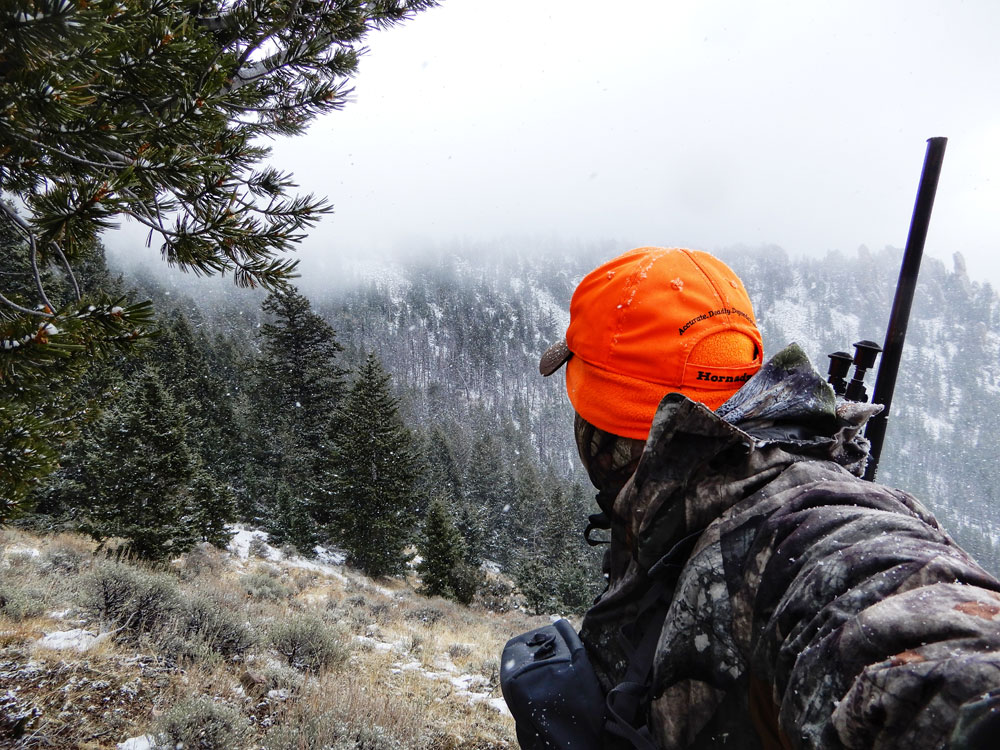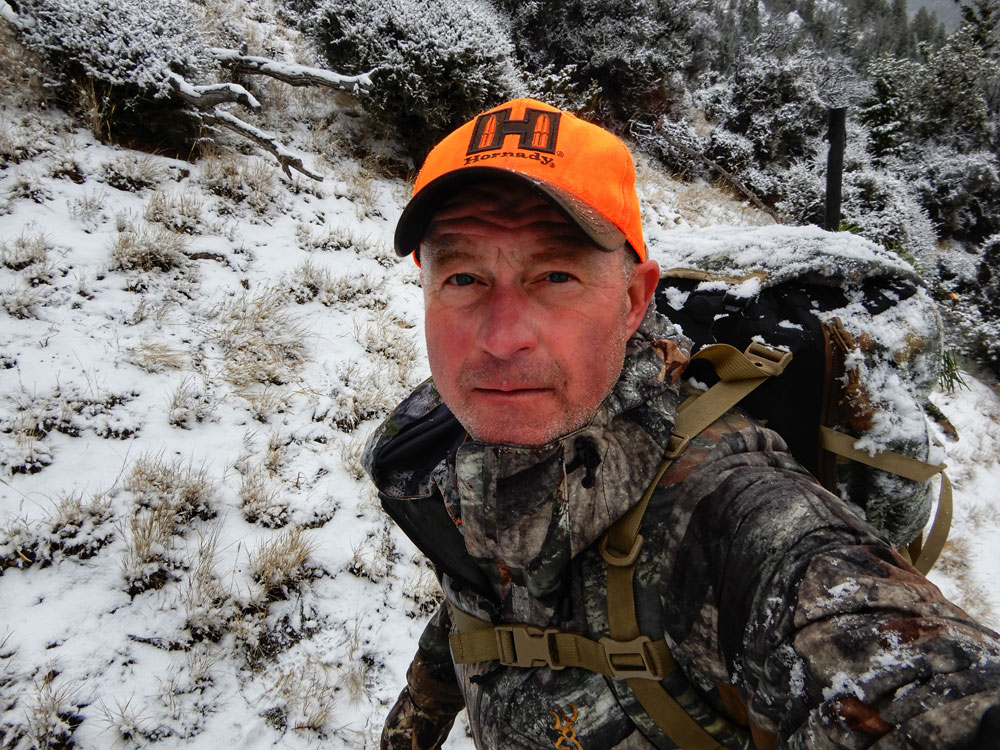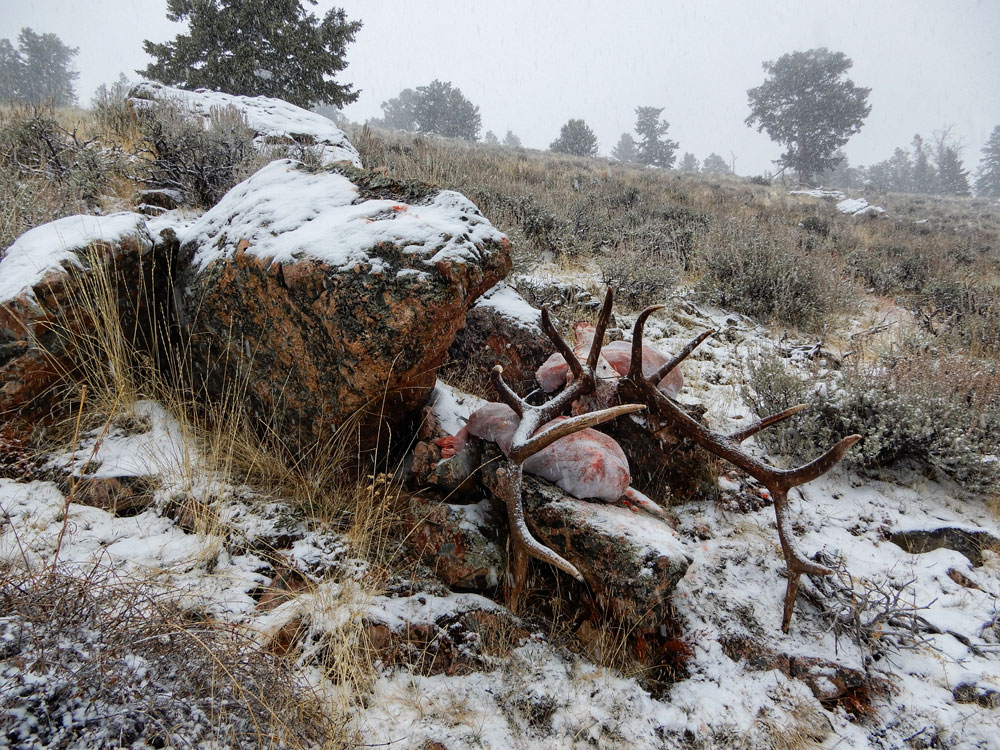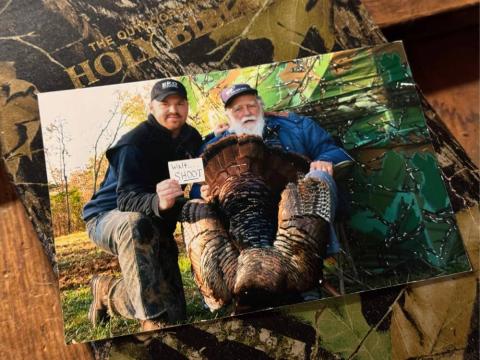Mark Kayser
“I’m looking at Google Earth. I am wondering why you did that?”
I had to chuckle as I read the text from my buddy a state away. He was virtually veering down from above to GPS coordinates I supplied to him in case a wilderness emergency unexpectedly occurred on my DIY, public-land, solo elk hunt. I had just sent him a picture of the October bull elk I shot minutes prior. The reality of removing an entire elk from a near-vertical slope in the beginnings of a Wyoming snowstorm quickly sank in after a quick smile from the amusing text. It was now time to put on the big-boy pants, put down the smartphone and focus on a fast extraction.

For nearly a decade my elk hunting typically takes place in the warmer month of September. Armed with a bow versus a rifle seems like a disadvantage, but there are positives. Bugling bulls, moderate weather and no snow all equal good hunting. October bulls can be unsocial, temperatures become crazily variable and heaps of snow can halt a hunt overnight.
In 2019, changes in my autumn work timetable prompted me to try for a limited tag in a unit near my Wyoming home. Wyoming residents don’t receive preference points so I was more than surprised to see a “successful” notation behind my name after the elk draw. Then panic set in. Another round of unanticipated changes in my calendar revealed I only had three to four days tops to execute the hunt. That canceled any horseback camp deep in the backcountry and if I continued my ritual of solo hunting, I could only hunt two days tops. I’d need to save at least an entire day for packing if I was successful. There would be no hunting up until the last hour since I was booked on an early-morning flight on the back end of the hunt.
Discussing hunting plans with Levi, a hunting buddy from South Dakota, prompted him to offer up his assistance as a spotter and a meat packer on the short hunt. OK, maybe I guilted him into it since in September I took him into one of my Montana honey holes where he arrowed a nice bull on the archery opener. Plus, I gave up the next day of bowhunting to help him pack it out. Regardless, his presence in the plan would give me at least an extra day on the abbreviated bull hunt.

On the first morning of our hunt, we unloaded my two ATVs from the back of my horse trailer in morning darkness at 9,300 feet during a snowstorm. The plan was to blaze a trail through the snow up to 10,000 feet then drop in from above to south-facing slopes. After a half hour of fighting deep snow, low visibility and drifting conditions that covered our tracks in seconds, we both concurred. If the storm’s intensity whipped up it could strand us. Dawn hadn’t broke yet so it was time to execute plan B.
Returning and reloading the ATVs, we dropped in elevation. The top-down access was easier on the body, thus the reason to brave the high altitude. Coming into the same area from the bottom up erased snow issues, but was extremely more physically demanding. The trail to the same location was straight up and included a bit of rock climbing through some cliffs. The ascent took nearly an hour, but we both made it before the brunch hour.
By noon, we hadn’t seen any hunters near us, but we hadn’t seen any elk either. That’s when I got an uneasy feeling. Levi mentioned he was achy and a text from his wife said his daughter came down with the full-on flu complete with vomiting. At dusk, we dropped off the cliffs and back to the horse trailer for the night. I knocked myself out with a sleeping tablet after supper and the next morning woke to find a disheveled Levi fresh in from the cold after another round of puking. My packing partner was scratched from the starting lineup. Days later after a doctor’s visit it was discovered Levi came down with a severe case of altitude sickness including internal bleeding, possibly from our huge elevation changes in a short period of time.
Finding myself alone as usual, I climbed the cliff trail again in darkness to reach hopeful plateaus holding elk. It wasn’t until hours later at dusk that I spotted a lone bull several miles away. Unbelievably, it was feeding along an ATV trail, but hidden by timber. I marked the location on my HuntStand hunting app and before dawn broke the next morning I was overlooking the location waiting for shooting light.
The area was littered with elk tracks, but again, no sightings. Hiking to a vantage point I soon spotted new elk in a foggy, high basin miles away. More than a dozen elk mingled between two openings and I could make out antlers on one of them despite the extreme distance. The sheer makeup of the basin caused me to rethink an assault, but with time running out I ignored common sense.
By early afternoon, I had made the 1,750-foot ascent to the middle bench between the two openings in the basin. The elk had slipped into adjacent dark timber, but their tracks and musky odor lingered throughout the extreme slopes. I set up in a location to watch the upper and lower openings for the remaining daylight hours. A fierce wind kicked up and before dark, I surmised the elk had taken a different exit route. A quick reconnaissance of the timber confirmed the elk dropped into a neighboring canyon to feed, but I had hope they’d rendezvous in the high basin at dawn.
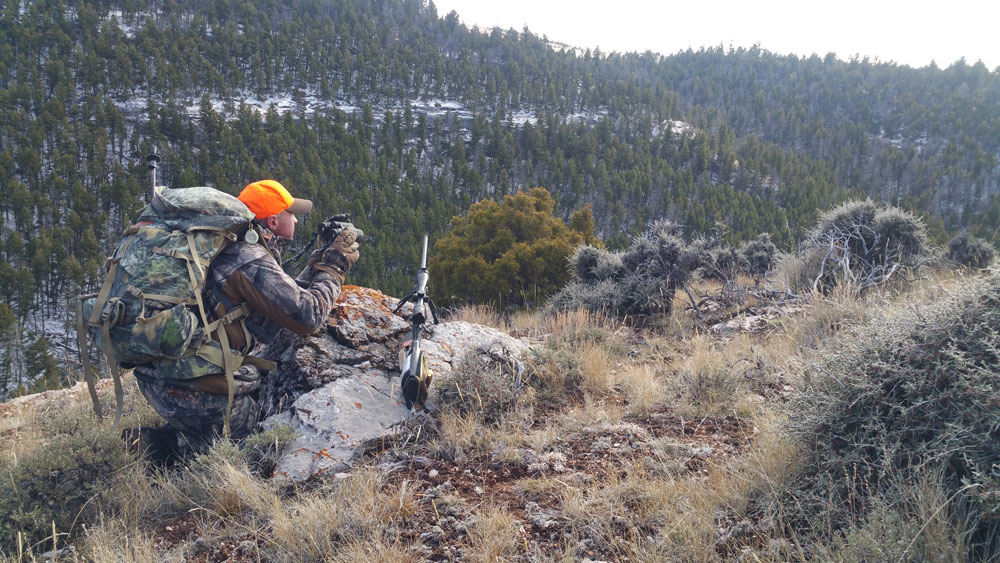
Waking a full hour earlier than normal, I made the grueling scramble up the mountain in total darkness complete with a couple of eye-poking branch collisions. Reaching the bench between the upper and lower openings, I pulled my extra clothes from my pack to layer up. My body was radiating massive amounts of heat, but the teen temperatures could quickly bring on life-threatening hypothermia. With the final zip, I lifted my Sig Sauer rangefinding binocular and immediately spotted not one, but two bulls above me at shooting light. My hunch was spot on.
Focusing, I soon confirmed two raghorn bulls and although I love elk meat, I also held a late-season antlerless tag in a more hospitable zone to fill the freezer. I kept scanning for bulls with more headgear. Out of the far corner of the upper basin, I spied two more bulls partially obscured by a lone tree between us. As the two played hide-and-seek behind the boughs, I was able to field-judge the duo. Both were respectable 6x6 bulls, but the near bull had a slight advantage in overall point length and a noticeably larger dividend of mass. Unfortunately, he was winning at hide-and-seek behind the tree.
The disappearance of the raghorns into the timber prompted him to slowly feed that direction and when he stepped from behind the tree, I re-zapped him with my Sig to confirm 319 yards. Rechecking my Bergara, I took a glance and settled to send a .300 Winchester magnum round up the steep angle. The Hornady ELD-X bullet hit hard and I realigned my reticle view ready for a follow-up shot when the bull wobbled out of sight behind that damn tree!
My next sight of the view of the bull left me traumatized! The giant body of the big bull shot out from behind the tree cartwheeling end for end down the slope. It was as dramatic as any sheep or mountain goat tumble I’ve seen on YouTube. All I could picture was retracing the summersault to pick up pieces of snapped-off antlers.
After he disappeared out of sight, it took me another 30 minutes of uphill struggle to reach the downed bull. Astonishingly, when I peered down at the wedged bull his entire rack was intact. I sat down next to the backcountry marvel in awe of what just had taken place and said an unspoken thanks to my protector above. That’s also when I sent a couple of texts out to my wife, kids and Levi, prompting his questioning response. “I’m looking at Google Earth. I am wondering why you did that?”

After soaking in the experience, the sight of snowflakes jolted me back to the urgency of the task at hand. I was now nearly 2,000 feet vertically above any level landscape and nearly three miles from the trailhead. Add to the equation the act of removing up to 300 pounds of deboned elk, plus hunting equipment and the antlers with skull intact as a storm approached. It teleported me back to the job before me. Because of time constraints, I opted to break the bull into three pack loads meaning all but one would be north of 100-pound loads.
After deboning the elk with another elk summersault, downhill session at mid-job, I busted the first load down the mountain. Poor visibility in the storm caused me to detour down a wrong ridge, but I rerouted and dropped the first load at the trailhead. Before the sun set I returned to pack out a second load. Feeling a runner’s high, I hoisted the skull on my shoulders making the dusk hike a backbreaking descent.
Early the next morning, I ascended for the last load and reached it just as another storm began dumping snow. After breaking camp, I made it home just in time to re-pack and catch a flight with my wife to attend a West Point football game in New York with our son Cole who is in his final year at the U.S. Military Academy. The after-game tailgate was a twofold celebration of family and success after another demanding DIY hunt with solo determination.
Gear to Get It Done in DIY Style
- Camouflage: Mossy Oak Elements Terra in ScentLok. Rain gear layering in Mossy Oak Treestand
- Clothing Layering System: Nomad in Mossy Oak Mountain Country
- Optics: Sig Sauer KILO3000BDX laser range-finding binocular and Sierra3BDX riflescope
- Rifle: Bergara Premier Mountain Rifle, .300 Winchester magnum
- Ammunition: Hornady Precision Ammunition with the ELD-X 200-grain bullet
- Backpack: Cabela’s Instinct Backpack
- Boots: Cabela’s Denali by Meindl Hunting Boots
- Gaiters: Outdoor Research Gaiters
- Hunting App: HuntStand



